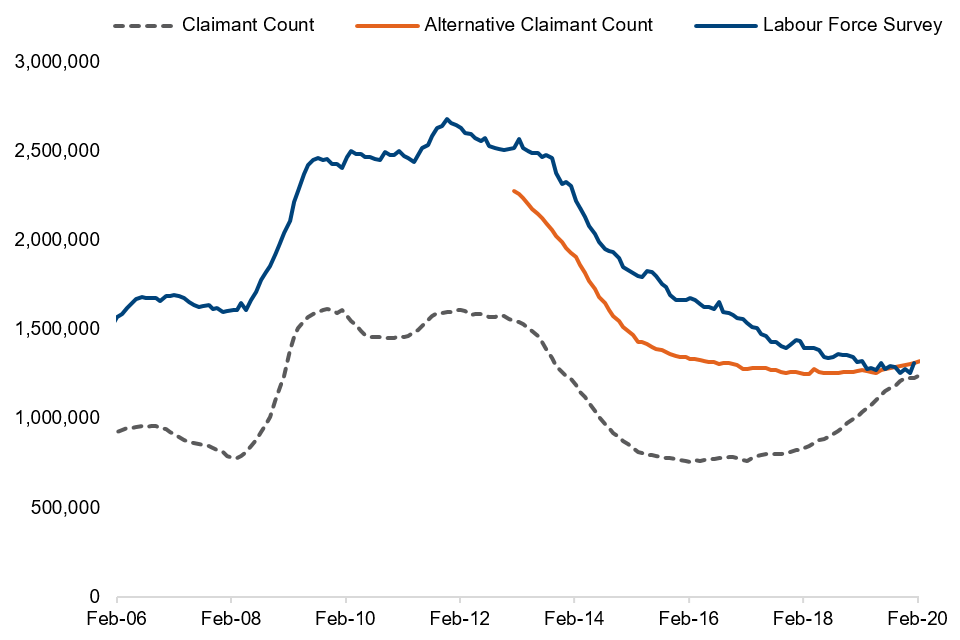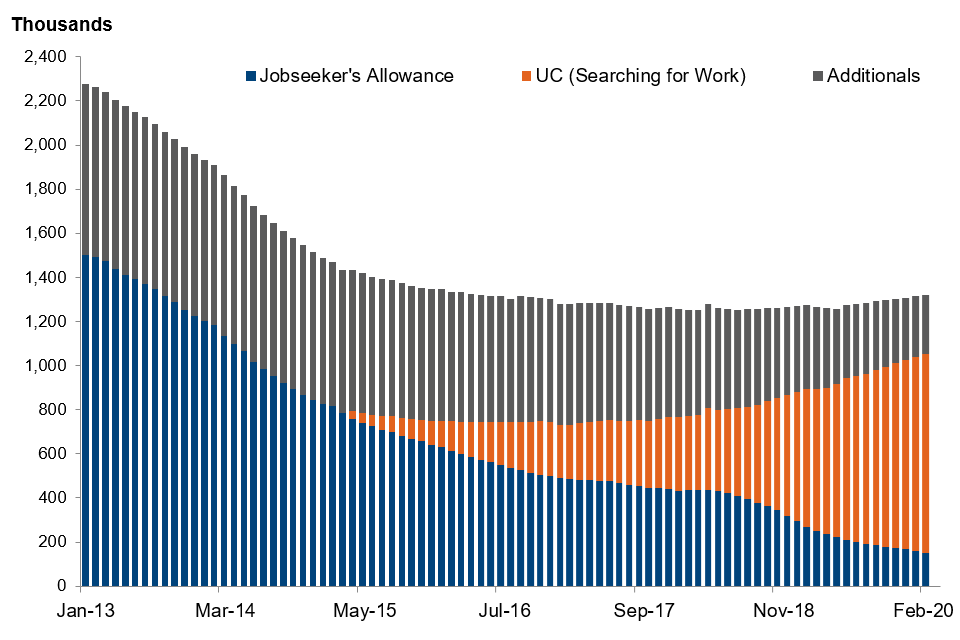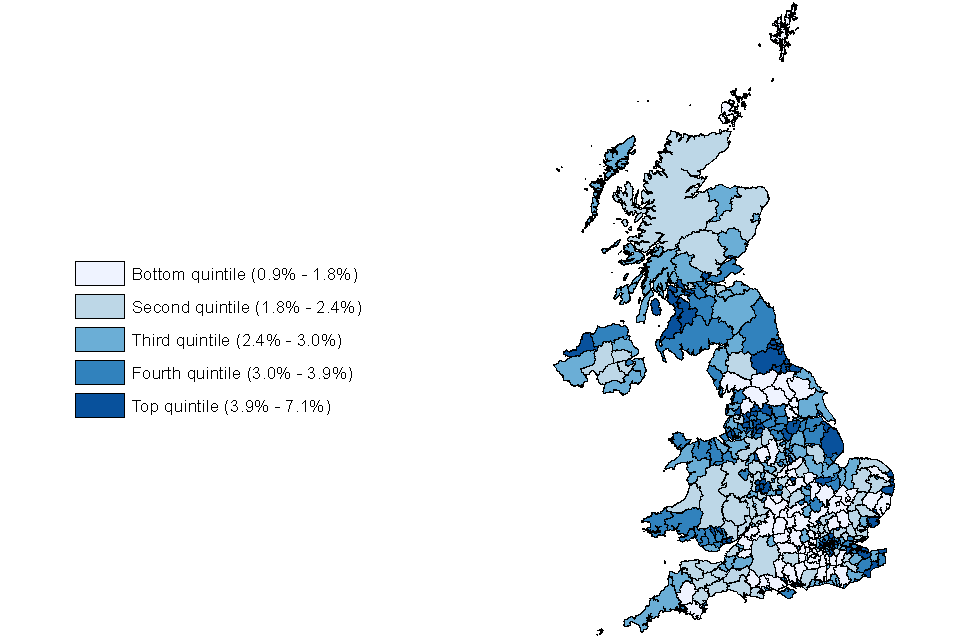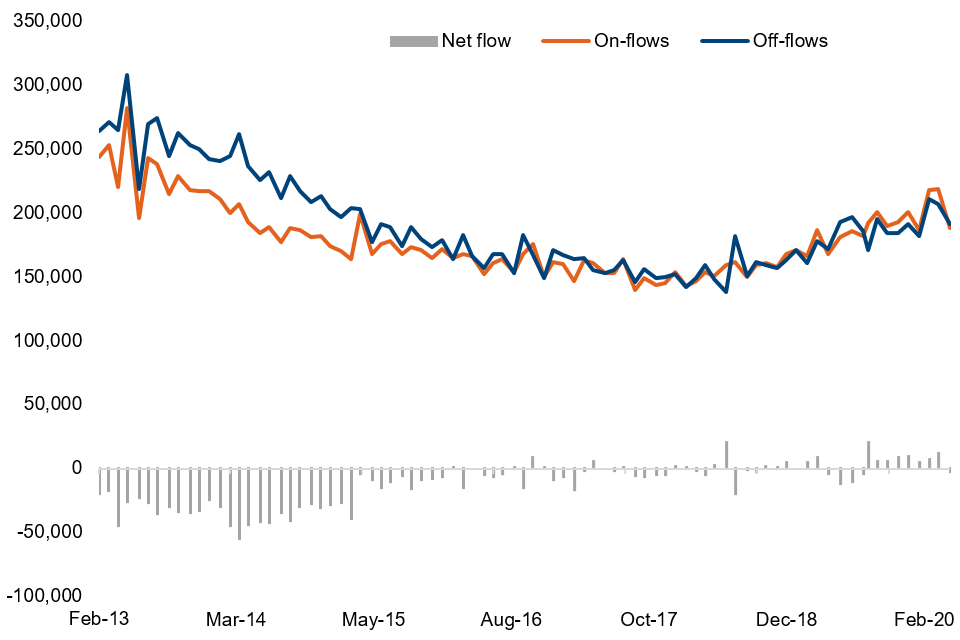Alternative Claimant Count statistics January 2013 to February 2020
Updated 12 May 2020
The latest release of these statistics can be found in the Alternative Claimant Count statistics collection.
This release includes revisions to previous statistics. Figures are seasonally adjusted unless otherwise stated.
We are continuing to review the frequency of updates to the Alternative Claimant Count statistics and would welcome views from users.
Feedback and queries about the statistics can be sent by email to stats.consultation-2018@dwp.gov.uk.
1. Main Stories
In the United Kingdom, the number of people claiming unemployment related benefits in February 2020 was 1.32 million.
This is a:
- 0.7% increase in the last month
- 1.7% increase in the last quarter
- 3.8% increase in the last year
- 10.1% decrease in the last 5 years
Over the last quarter, there were 625,000 people newly claiming unemployment benefits and 609,000 no longer claiming, pushing up the count.
The claimant unemployment rate (as a proportion of the population aged 16 to 64) in February 2020 was 3.2%.
This rate has:
- remained broadly consistent compared to February 2019 (3.1%)
- fallen by 0.4 percentage points compared to February 2015 (3.6%)
Of the 1.32 million people in the United Kingdom in February 2020:
-
152,000 (12%) were claiming Jobseeker’s Allowance and 900,000 (68%) were in the Searching for Work conditionality group under Universal Credit – the remaining 270,000 were ‘additionals’
-
709,000 (54%) were male and 614,000 (46%) were female – in comparison, males represented 52% in February 2019, 2 percentage points lower than in February 2015 (54%)
-
220,000 (17%) were young people aged 16 to 24 – this compares to 198,000 (16%) in February 2019, and 252,000 (17%) in February 2015
At regional level:
- the highest claimant unemployment rate in February 2020 was for the North East at 4.4%
- the lowest was for the South West at 2.2%
At local authority level (figures not seasonally adjusted):
- the claimant unemployment rate ranges from 0.9% in the Isles of Scilly to 7.1% in Blackpool
- 107 local authorities (27%) saw a fall in the claimant unemployment rate between February 2019 and 2020
2. What you need to know
The Alternative Claimant Count measures the number of people claiming unemployment related benefits. Before 2013 this was simply the number of people claiming Jobseeker’s Allowance. However, since the introduction of Universal Credit from April 2013 the Claimant Count is measured as the number of people claiming Jobseeker’s Allowance and the number of Universal Credit claimants placed in the ‘Searching for Work’ conditionality group.
Under Universal Credit, a broader span of claimants are required to look for work than under Jobseeker’s Allowance. This is a feature of the design of Universal Credit which brings additional groups of people into ‘Searching for Work’ conditionality to help encourage and support these claimants into work. This has the effect of increasing the Claimant Count irrespective of how the economy performs. For this reason, the Office for National Statistics (ONS) withdrew the Claimant Count from their national Labour Market Statistics Bulletin in March 2017, stating that the Claimant Count was no longer a reliable economic indicator. ONS stated that the change in composition of the count could leave users with a misleading representation of changes in the labour market.
To address this, these new Alternative Claimant Count statistics measure the number of people claiming unemployment related benefits by modelling what the count would have been if Universal Credit had been fully rolled out since 2013 (when Universal Credit began) with the broader span of people this covers, comprising:
- Jobseeker’s Allowance
- Universal Credit – Searching for Work conditionality (excluding those on the health journey pre-Work Capability Assessment)
- estimates of those additional claimants who would have been Searching for Work under Universal Credit had it existed over the entire time period from 2013
This last group includes:
- people who are not in work but previously claimed Housing Benefit only, this means did not claim Jobseeker’s Allowance
- people whose household previously claimed Child Tax Credit from HM Revenue & Customs (HMRC), but are not themselves earning more than the Universal Credit administrative earnings threshold; and nor do they have responsibility as the main carer for their child
- people who are the partner of a claimant of Employment and Support Allowance or Income Support, but who do not themselves have caring responsibilities, a disability or a limitation on their ability to work
The statistics thus provide:
- a consistent measure of local levels of claimant unemployment over time and across areas
- a better indication of labour market change
National and regional figures are seasonally adjusted. The purpose of this is to remove systematic calendar-related variation associated with the time of the year which could otherwise cause misinterpretation of trends within the data. This facilitates comparisons between consecutive time periods, rather than just year-on-year. Our approach to seasonal adjustment is consistent with the approach used by ONS for the Claimant Count. About these statistics contains more information about the process used.
The Alternative Claimant Count series starts from January 2013. Over a longer period, the Labour Force Survey provides a consistent measure of unemployment at national and regional level. Trends over time for local areas can be considered using the Claimant Count prior to 2013, and the Alternative Claimant Count from 2013. However the figures cannot be directly compared as they are defined differently (figure 1).
Figure 1: Comparisons between Alternative Claimant Count, Claimant Count and Labour Force Survey, United Kingdom, February 2006 to 2020, seasonally adjusted

Source: DWP Alternative Claimant Count statistics and ONS Claimant Count statistics and Labour Force Survey.
Figure 2 illustrates the differences between the Alternative Claimant Count and the Claimant Count at a local level. For Newcastle-upon-Tyne (which was one of the first local authorities to roll out Universal Credit Full Service to new claimants in May 2016), the Claimant Count subsequently rose as more people were brought within Searching for Work conditionality. This was irrespective of changes in the local labour market. Under Universal Credit, claimants are assigned to conditionality groups which translate to the work-related tasks the individual must do in order to fulfil entitlement conditions. The Searching for Work conditionality group comprises those people who are not working, or have very low earnings. The claimant is required to take action to secure work/better paid work.
These new statistics measure claimant unemployment in Newcastle-upon-Tyne by modelling what the count would have been if Universal Credit had been fully rolled out since 2013. Changes in the series over time and comparison to other areas thus provide more meaningful insights to changes in the local labour market.
Figure 2: Newcastle-upon-Tyne local authority: Claimant Count and Alternative Claimant Count, January 2013 to February 2020, not seasonally adjusted

Source: DWP Alternative Claimant Count statistics and ONS Claimant Count statistics.
3. United Kingdom
In the United Kingdom, the number of people claiming unemployment related benefits in February 2020 was 1.32 million. This is a 3.8% increase from February 2019.
Figure 3 shows the fall in Jobseeker’s Allowance both before Universal Credit roll out (linked to an improving labour market), and during Universal Credit roll out (linked to the transition of claims to Universal Credit). At February 2020, the Universal Credit Searching for Work conditionality group covered over two thirds (68%) of all claimants. In comparison, at February 2019 just under half of all claimants (49%) were in this group.
Figure 3: Number of people claiming unemployment related benefits by type of claimant, United Kingdom, January 2013 to February 2020, seasonally adjusted

Source: DWP Alternative Claimant Count statistics.
Notes about figure 3.
- ‘additionals’ comprise claimants who would have been Searching for Work under Universal Credit had it existed over the entire time period from 2013.
To put these figures into context, figure 4 shows the claimant unemployment rate as a proportion of the population aged 16 to 64 by gender since January 2013.
The overall rate in February 2020 was 3.2%, broadly consistent with February 2019 (3.1%). It has fallen by 0.4 percentage points compared to February 2015.
Figure 4: Monthly claimant unemployment rate by gender, United Kingdom, January 2013 to February 2020, seasonally adjusted

Source: DWP Alternative Claimant Count statistics and ONS Claimant Count population statistics.
Gender
Figure 5 shows how the gender split of claimants began to equalise over time but has since shown a subtle rise in male claimants in the most recent year. In February 2015, 54% of claimants were male. Over time, that proportion gradually decreased to around 52% in February 2019 but has since risen to 54% in February 2020.
Figure 5: Number of people claiming unemployment related benefits by gender, United Kingdom, February 2015 to February 2020, seasonally adjusted
| Month | Male | Female | Total |
|---|---|---|---|
| February 2020 | 709,000 | 614,000 | 1,323,000 |
| February 2019 | 663,000 | 611,000 | 1,274,000 |
| February 2018 | 651,000 | 598,000 | 1,249,000 |
| February 2017 | 674,000 | 604,000 | 1,278,000 |
| February 2016 | 717,000 | 616,000 | 1,333,000 |
| February 2015 | 797,000 | 674,000 | 1,471,000 |
Source: DWP Alternative Claimant Count statistics.
Age
Youth claimant unemployment (those aged 16 to 24) was 220,000 in February 2020 (17% of total claimant unemployment), up 1 percentage point from the same time last year.
Additionals
The additional group of unemployed claimants are estimates of those who would have been Searching for Work under Universal Credit had it existed over the entire time period from 2013. This covers:
- people who are not in work but previously claimed Housing Benefit only, this means did not claim Jobseeker’s Allowance
- people whose household previously claimed Child Tax Credit from HMRC, but are not themselves earning more than the Universal Credit administrative earnings threshold; and nor do they have responsibility as the main carer for their child
- people who are the partner of a claimant of Employment and Support Allowance or Income Support, but who do not themselves have caring responsibilities, a disability or a limitation on their ability to work
Of the 1.32 million people claiming unemployment benefits in February 2020, 270,000 (20%) were ‘additionals’.
The largest group of additionals (57%) were those people not in work but claiming Housing Benefit only.
Figure 6: Additional claimants by type of claimant, United Kingdom, February 2020, seasonally adjusted
| Month | Child Tax Credits (%) | Housing Benefit only (%) | Partner of IS claimant (%) | Partner of ESA claimant (%) | Other Additionals (%) |
|---|---|---|---|---|---|
| February 2020 | 38.3 | 56.5 | 0.5 | 4.5 | 0.2 |
Source: DWP Alternative Claimant Count statistics.
4. Regional
Of the 1.32 million people claiming unemployment benefits in February 2020, almost a sixth (214,000) were living in London. The next highest region was the North West with 172,000, followed by the West Midlands with 150,000.
Compared to February 2019, there were three regions that saw decreases in claimant unemployment benefits. Northern Ireland saw the largest decrease at 9.5%, followed by Scotland at 1.3% and the North East at 1.1%. The South East saw the largest increase of 8.4% on the previous year, followed by London and the East, both at 7.2%.
The highest claimant unemployment rate in the United Kingdom in February 2020 was for the North East (4.4%). The next highest was for the West Midlands (4.0%). The region with the lowest claimant unemployment rate was the South West (2.2%). See figure 7 for more information on other regions.
Figure 7: Claimant unemployment rate by region, United Kingdom, February 2020, seasonally adjusted
| Region | Claimant unemployment rate (%) | Change on year |
|---|---|---|
| North East | 4.5 | 0.0 |
| North West | 3.8 | 0.1 |
| Yorkshire and the Humber | 3.6 | 0.1 |
| East Midlands | 2.8 | 0.1 |
| West Midlands | 4.1 | 0.2 |
| East | 2.5 | 0.2 |
| London | 3.6 | 0.3 |
| South East | 2.3 | 0.2 |
| South West | 2.3 | 0.1 |
| Wales | 3.3 | 0.1 |
| Scotland | 3.2 | 0.0 |
| Northern Ireland | 2.7 | -0.3 |
Source: DWP Alternative Claimant Count statistics
5. Local area
In February 2020, the highest claimant unemployment rate across all local authorities was Blackpool (7.1%). It was also one of the top 5 local authorities with the largest percentage point rise since February 2019 (up 0.6 percentage points). The next highest was Birmingham (also 7.1%) followed by Wolverhampton (6.6%).
The local authorities with the lowest rates were the Isles of Scilly (0.9%), Hart (1.1%) and South Northamptonshire (1.2%).
Figure 8 shows a map of claimant unemployment rates by local authority in February 2020. It shows 5 bands each containing approximately 78 (20%) local authorities.
The bottom quintile (light blue) shows the group of local authorities which have the lowest claimant unemployment rates.
The top quintile (dark blue) shows the group of local authorities which have the highest claimant unemployment rates in the United Kingdom. This view allows for better comparison of claimant unemployment rates across local authorities irrespective of the rollout of Universal Credit.
Figure 8: Claimant unemployment rate by local authority (quintiles), United Kingdom, February 2020, not seasonally adjusted

Source: DWP Alternative Claimant Count statistics and ONS Claimant Count population statistics.
View the information in figure 8 as an interactive map.
Notes about figure 8.
-
data is banded using quintiles. This means group ranges are calculated to split local authorities evenly, so 20% of local authorities fit into each group.
-
rates are calculated by dividing the number of people claiming unemployment related benefits in a local authority by the population aged 16 to 64 in that local authority.
-
rates have been calculated using the mid-2018 population estimates as, at the time of release, this was the latest data available.
-
care should be taken on interpreting local authorities with small figures as this can have larger impacts on the rate and rate of change.
-
Figures are not seasonally adjusted.
Figure 8 shows a number of areas in the top quintile including parts of the North East, southern parts of the North West, Yorkshire and the Humber, northern and southern parts of Wales, south western parts of Scotland and areas within the South East, Birmingham and London.
In contrast, the bottom quintile covers areas including the majority of the East, South East and the West Midlands.
Figure 9 shows a map of the change of claimant unemployment rate between February 2019 and February 2020 by local authority.
Figure 9: Change in claimant unemployment rate by local authority (quintiles), United Kingdom, February 2019 to February 2020, not seasonally adjusted

Source: DWP Alternative Claimant Count statistics and ONS Claimant Count population statistics.
View the information in figure 9 as an interactive map.
Notes about figure 9.
-
read the notes about figure 8.
-
figures are based on percentage point rate of change between February 2019 and February 2020.
Pendle saw the largest percentage point increase in claimant unemployment rate over the last year. Bradford saw the second largest rise followed by Portsmouth (all 0.6 percentage points).
Across all local authorities, over a quarter (27%) saw a fall in their claimant unemployment rate between February 2019 and 2019. The largest decrease was in Hartlepool (0.9 percentage points), followed by Derry City (0.7 percentage points) and North East Lincolnshire (0.5 percentage points).
6. Flows
Stat-Xplore includes newly published standardised statistics on:
On-flows: the number of people claiming unemployment related benefits in one month, who were not claiming in the previous month.
Off-flows: the number of people no longer claiming unemployment related benefits in one month, who were claiming in the previous month.
These statistics are available by month (February 2013 to February 2020), by local area, benefit type and by age/gender. They offer some insights to users on monthly changes in a local area - for example the proportion of the Count which represents new claims in the previous month, and the off-flow rate - a measure of how the local labour market is performing.
Figure 10 shows the number of on-flows and off-flows, along with the net number of flows for each month.
Figure 10: Flows between claimant unemployment, United Kingdom, February 2013 to February 2020, standardised and seasonally adjusted

Source: DWP Alternative Claimant Count on-flow and off-flow statistics.
The statistics released in Stat-Xplore allows users to produce local area analyses of flows over time.
7. About these statistics
The statistics are experimental Official Statistics, badged as provisional (for the latest 3 months) and are subject to revision in future releases.
Like many economic indicators, the labour market is affected by factors that tend to occur at around the same time every year; for example, school leavers entering the labour market in July and whether Easter falls in March or April. In order to compare changes over time that are not driven by seasonal factors, the data has been seasonally adjusted. This allows for comparisons between consecutive time periods, for example, to the previous quarter or month. All figures stated in this statistical release are seasonally adjusted except where otherwise stated. Figures at local authority level and below are not seasonally adjusted as a meaningful multiplicative model which contains other metrics cannot be produced at such a low level of data. Figures for flows are not currently seasonally adjusted but are being worked on for January’s release.
From January 2020, a number of methodological improvements were integrated into the series. These had the effect of revising the historic Count at national and local area level. The methodology changes comprised:
-
Improved methods for identifying people awaiting a Universal Credit Work Capability Assessment. A new set of identification rules for Work Barrier to Health cases has been agreed with operational and policy colleagues and now reflected in the statistic
-
Improved methods for assessing the work status of ‘additionals’. A more defined derivation for tax credit claimants where information held on current employment status combined with hours worked suggest they will transition to Universal Credit – Searching for Work.
The background and methodology document provides a fuller explanation on the purpose, coverage, construction, sources and limitations of the statistics. For example, this includes an explanation of why the back series starts in 2013 (linked to data availability) and on how the claimant unemployment rates have been calculated.
Lead Statistician: Luke Stockham
ISBN: 978-1-78659-224-8
